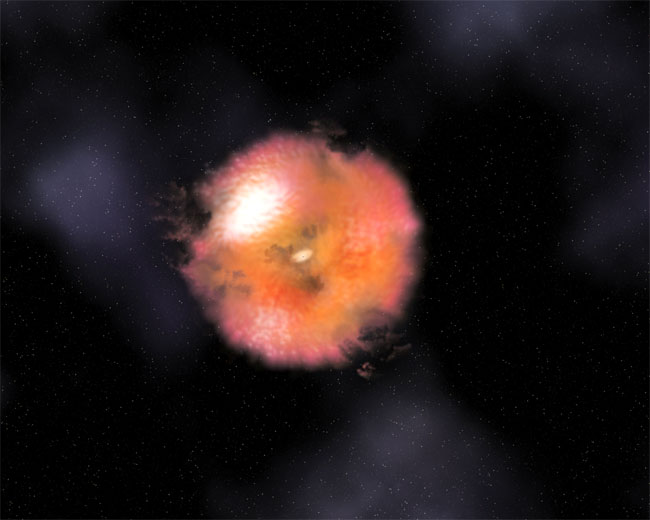
Some galaxies hide the normally bright output of supermassive black holes at their centers behind thick veils of dust and gas, a new study finds.
This phenomenon occurs in a type of galaxy called active galactic nuclei, or AGN, which that have active supermassive black holes at their cores. The black holes feed on infalling gas and many emit powerful beams of radiation from their poles that shine with the energy of billions of stars, making them some of the most luminous objects in the universe.
In the newly discovered type of “hidden” AGN, the central black hole is so heavily shrouded by gas and dust that no visible light escapes. As a result, these galaxies are difficult to detect and were missed by previous AGN surveys.
“This is an important discovery because it will help us better understand why some supermassive black holes shine and others don’t,” said study leader Jack Tueller of NASA’s Goddard Space Flight Center in Maryland.
The finding, detailed in the Aug. 1 issue of Astrophysical Journal Letters, could also force scientists to reconsider the role they think supermassive black holes play in the evolution of their host galaxies.
Hidden black holes
Scientists have been steadily gathering evidence for this new type of AGN for the past two years. Using NASA’s Swift Telescope, Tueller and his colleagues spotted about 40 relatively nearby AGNs that were previously overlooked because their visible and ultraviolet light was dimmed by gas and dust.
Get the Space.com Newsletter
Breaking space news, the latest updates on rocket launches, skywatching events and more!
Swift uncovered the AGNs because the telescope can detect high-energy X-rays, which can pierce through the dust and gas.
“These are the same energies as the x-rays used in the doctor’s office,” Tueller told SPACE.com. “They’re very penetrating. They can go through the human body. They can go through that accreting torus of matter.”
The discoveries were followed up by American and Japanese astronomers using the U.S./Japanese Suzaku X-ray observatory.
Scientists think AGNs are surrounded by donut-shaped rings of swirling material, which provide the fuel for the black holes. AGNs are divided into several types depending on the viewing angle at which this ring is angled toward Earth. A “blazer,” for example, is an AGN whose ring, or “torus,” lies roughly perpendicular to us. As a result, one of its twin jets points directly at us.
Shells, not rings
Richard Mushotzky, an astronomer also at NASA Goddard and a member of Tueller’s team, thinks the new AGNs are surrounded by a shell of gas and dust, instead of a typical ring. This would have the effect of hiding nearly all of the visible and ultraviolet light produced by the AGN.
“We can see visible light from other types of AGN because there is scattered light,” Mushotzky explained. “But in these two galaxies, all the light coming from the nucleus is totally blocked.”
The researchers estimate that hidden AGNs could provide up to 20 percent of the X-ray background, a glow of X-ray radiation that pervades the universe.
Factoring in these new types of objects help scientists better understand how supermassive black holes and their host galaxies co-evolve, the researchers say.
“We think these black holes have played a crucial role in controlling the formation of galaxies, and they control the flow of matter into [star] clusters,” Tueller said. “You can’t understand the universe without understanding giant black holes and what they’re doing.”
- VIDEO: Black Hole Diving
- NASA Completes Survey of Nearby Supermassive Black Holes
- Vote Now: The Strangest Things in Space
Join our Space Forums to keep talking space on the latest missions, night sky and more! And if you have a news tip, correction or comment, let us know at: community@space.com.
Ker Than is a science writer and children's book author who joined Space.com as a Staff Writer from 2005 to 2007. Ker covered astronomy and human spaceflight while at Space.com, including space shuttle launches, and has authored three science books for kids about earthquakes, stars and black holes. Ker's work has also appeared in National Geographic, Nature News, New Scientist and Sky & Telescope, among others. He earned a bachelor's degree in biology from UC Irvine and a master's degree in science journalism from New York University. Ker is currently the Director of Science Communications at Stanford University.









